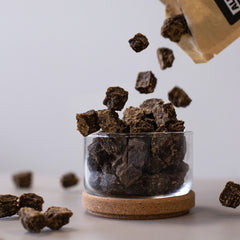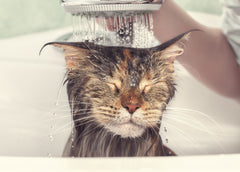Dandruff in cats: A problem with many causes
Dandruff in cats can dull even the shiniest coat and is often a cause for concern. While occasional flaking is harmless, it can also indicate skin problems or other health issues. But don't panic! With the right care, nutrition, and attention, you can quickly get the problem under control. In this blog, you'll learn all about the causes of dandruff, possible treatments, and how to sustainably promote your cat's skin health.
What is dandruff in cats anyway?
Dandruff is dead skin cells that appear as small white flakes on your cat's fur and skin. A certain amount of dandruff is normal, as the skin is constantly renewing itself. However, if the flakes become visible or increase, there is often a problem.
Is dandruff normal in cats?
- A few flakes can be normal, especially during the heating season.
- However, excessive dandruff is a sign of an imbalance or health problem.
Causes of dandruff in cats
There are many reasons for dandruff in cats. It can be caused by anything from harmless triggers like dry air to serious illnesses.
Common causes:
- Dry skin: Especially during the heating season or when humidity is insufficient.
- Obesity: Overweight cats cannot reach certain areas when grooming, which leads to dandruff.
- Parasites: Fleas, mites or fungal infections can irritate the skin and cause dandruff.
- Allergies: Reactions to food, pollen or house dust can also show up on the skin.
- Skin diseases: Diseases such as seborrhea or skin fungus often lead to dandruff.
- Stress: Changes in environment or routine can affect skin health.
- Incorrect diet: A deficiency in essential fatty acids or vitamins often shows up in the skin.
- Diseases: Diabetes or thyroid problems can also cause dandruff.
How do you know if your cat's dandruff is a problem?
Occasional dandruff is usually harmless, but certain signs require attention.
Warning signs:
- Severe itching: Your cat scratches frequently.
- Hair loss: Accompanied by bald patches in the coat.
- Skin redness: Visible inflammation or sores.
- Unpleasant odor: May indicate a skin infection.
- Changed behavior: withdrawal or increased restlessness.
If you notice any of these symptoms, you should consult a veterinarian.
Treating dandruff in cats: The best approaches
Treatment for dandruff in cats depends on the cause. Often, a combination of grooming, diet, and, if necessary, veterinary treatment is required.
1. Skin care
- Brushing: Regular brushing promotes blood circulation and removes loose skin cells.
- Gentle shampoos: Use mild products specifically designed for cats.
2. Nutrition
- Fatty acids: Omega-3 and omega-6 fatty acids support skin health.
- High-quality food: Make sure you feed your dog a balanced diet without unnecessary additives.
3. Hydration
- Humidity: Use a humidifier, especially in winter.
- Water consumption: Make sure your cat drinks enough.
4. Parasite control
- Flea medication: Regular flea treatments prevent skin irritation.
- Mite remedies: Spot-on preparations help with mite infestation.
5. Stress management
- Quiet environment: Create a stress-free space for your cat.
- Routine: Cats react sensitively to changes, so a fixed routine helps.
Natural remedies for dandruff in cats
If you are looking for a gentle way to treat dandruff, natural remedies can help.
Tips for natural treatment:
- Coconut oil: Has antibacterial and moisturizing properties. Massage a small amount into the coat.
- Aloe Vera: Soothes irritated skin and moisturizes.
- Olive oil: A drop in food can promote skin health.
Remember that natural remedies should only be used as a supplement and should not treat the cause.
When should you go to the vet?
If your cat's dandruff does not go away despite care or is accompanied by other symptoms, a visit to the vet is advisable.
Examination methods:
- Skin swab: For parasites or fungi.
- Blood test: To check for systemic diseases.
- Allergy tests: To identify possible allergens.
How can you prevent dandruff in cats?
Prevention is the best way to avoid dandruff. With a few simple steps, you can promote your cat's skin and coat health.
1. Regular grooming
- Brush your cat at least once a week.
2. High-quality nutrition
- Make sure you choose food that is high in omega fatty acids.
3. Parasite control
- Protect your cat regularly from fleas and mites.
4. Stress reduction
- Create a relaxed environment and avoid unnecessary changes.
5. Hydration
- Ensure sufficient fresh water and a pleasant humidity.
Frequently asked questions about dandruff in cats
“Can cats have dandruff?”
Yes, cats can have dandruff, especially if their skin is dry or their coat is not well groomed.
“Is dandruff dangerous for cats?”
Not always. Occasional dandruff is usually harmless, but it can be a sign of a larger problem.
“What helps quickly against dandruff?”
Regular brushing, an appropriate diet and sufficient hydration often help quickly.
“Should I use an anti-dandruff shampoo on my cat?”
Only if it's specifically formulated for cats. Human shampoos are unsuitable.
Conclusion: Dandruff in cats – A solvable problem
Dandruff in cats is usually not a cause for alarm, but it can indicate health problems. The most important points at a glance:
- Recognize symptoms: Excessive flaking, itching, or redness require attention.
- Adjust treatment: From brushing to veterinary treatment, there are many options.
- Prevention: A good diet, regular grooming and parasite control help prevent dandruff.
With the right care, you can ensure that your cat maintains a shiny, dandruff-free coat – and feels completely comfortable!
















